| |
|
|
|
PACIFIC FORKTAIL
Ischnura cervula
|
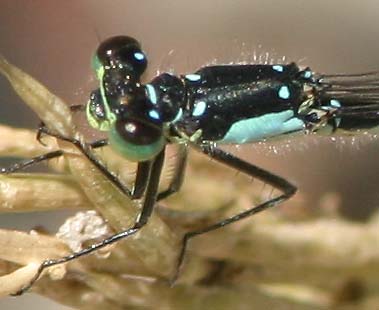 |
|
|
Pacific Forktail is a common and
widespread little damselfly. Only an inch in length, the male is
nonetheless easily recognized by the four tiny blue dots atop the black
upper surface of the thorax. It frequents aquatic edges – ponds to
marshes to drainage ditches – throughout much of the year.
|
|
photo (above)
23 July 2006 Salinas wastewater ponds
photo (below) 21 Oct 2006 Lake San Antonio
|
|
|
| Beyond the thorax pattern, males (above &
below) are characterized by aqua-blue sides to the thorax, black atop
the abdomen, and an extensive blue patch on segments 8 & 9, which
the blue on top the segments connecting around the sides to the blue
undersides. Note also the green lower half to the eyes and around the
face. Males have impressive and complex appendages (see Manolis 2003
for details). Among the habitats preferred are small ponds with much
duckweed (below). |
|
|
|
photo (above)
9 July 2006 Laguna Grande
photo (below) 7 July 2006 Carmel River mouth
|
|
|
While male Pacific Forktails are rather
straightforward, the identification of females is complex as they come
in two types and change pattern as they age. Of course, when found "in
wheel" (left), one can assume that the female is actually a Pacific
Forktail! |
|
| Female Pacific Forktails typically oviposit
alone. This one (below) is depositing eggs well below the surface of
the duckweed-topped pond. This is a gynomorphic female that looks quite
different than the male, with Army-green sides to the thorax crossed by
a thin side stripe. |
|
|
|
photo (above)
19 July 2006 Laguna Grande
photo (below) 10 Mar 2007 Laguna Grande
|
|
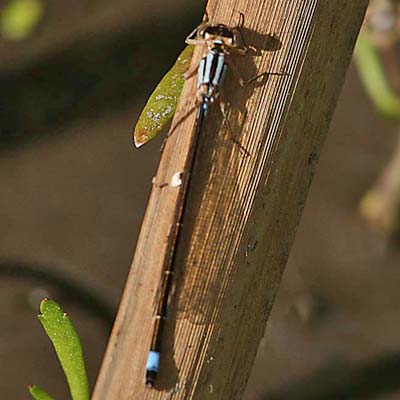 An andromorphic female is more
like a male with an aqua-blue and black pattern, but this one (right)
is quite young because of the orange spots behind the eye. Note that
the "blue tail" (blue patch near end of abdomen) encompasses only the
8th segment in females (males have both 8th & 9th segments blue).
Some andromorphic females are almost identical to males; others have a
'dash-and-a-dot' pattern atop the thorax (like an exclamation point),
but all have only one abdominal segment blue. An andromorphic female is more
like a male with an aqua-blue and black pattern, but this one (right)
is quite young because of the orange spots behind the eye. Note that
the "blue tail" (blue patch near end of abdomen) encompasses only the
8th segment in females (males have both 8th & 9th segments blue).
Some andromorphic females are almost identical to males; others have a
'dash-and-a-dot' pattern atop the thorax (like an exclamation point),
but all have only one abdominal segment blue.
Gynomorphic females have a bewildering array of
patterns as they change from immature (below left) to old, dark,
pruinose adults (below right). In all cases, though, the abdomen is
rather thin and looks long, compared to the shorter, much chunkier
abdomen of pruinose female Western Forktails.
|
Youngsters often have a thorax that is
white, tan, pale green, or pale blue, with thin side stripes, but
apparently some can even be orange.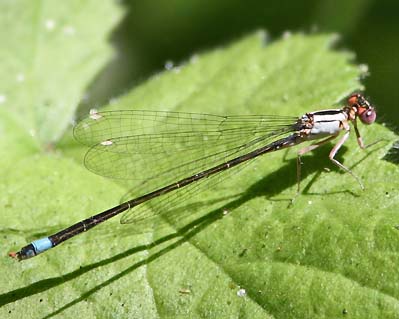
|
|
|
|
|
Some older females,
like this one (above), give me headaches. It is heavily pruinose,
including across the top of the thorax, recalling Western, but the
abdomen still too slim and long (I still misidentified it). It is
sometimes said that Pacific females have white pterostigma while
Western have dusky stigmas. This one, however, has a dusky pterostigma.
Dennis Paulson (in litt.) advises that while the stigma of Western
averages darker — they don't get as ghostly white as many Pacific — in
both species the stigma darkens with age. Thus an old Pacific, like
this one, can have a dusky pterostigma. Western at the same age should
be darker still — it can be black — but determining the age of these
little damsels is problematic. So there is another field mark to use
with caution.
photo (above left, half page) 6
July 2006 Frog Pond Natural Area
photo (above right, half page) 24 July 2006 Arroyo Seco Lakes
photo (above right, half page) 19 Sep 2006 Laguna Grande
|
 All young female Pacifics,
though, apparently have orange spots between the eyes on the back of
the head. Very young female Westerns are orange all over. All young female Pacifics,
though, apparently have orange spots between the eyes on the back of
the head. Very young female Westerns are orange all over. |
|
photo (above)
20 Sep 2006 Laguna Grande
|
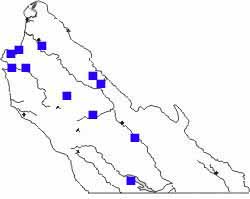 Pacific Forktail is a common and widespread
species in MTY, as it is across western North America. The map shows
selected locales of specimens or observations, but it likely occurs
almost anywhere, at least in the lowlands. Pacific Forktail is a common and widespread
species in MTY, as it is across western North America. The map shows
selected locales of specimens or observations, but it likely occurs
almost anywhere, at least in the lowlands.
Flight dates in MTY range from 10 March to 2
Dec, one of the longest spans among local odonates. It is often the
first ode of the spring. Elsewhere in California, this forktail has
been recorded in every month.
|
|
|
Literature cited:
- Manolis, T. 2003. Dragonflies and Damselflies of
California. Univ. of
Calif.
Press, Berkeley.
Web resources:
Major identification web sites with much information on California
odes include:
For sites with excellent photos to compare for identification or to
simply
enjoy, see:
Many of these sites have links to other useful pages.
Kathy Biggs's site is particularly useful in her selection of links.
|
|
All photos © Don Roberson
2007
TOP
|
|
|
Page created 14-15 Mar 2006
|
|
|
|
|


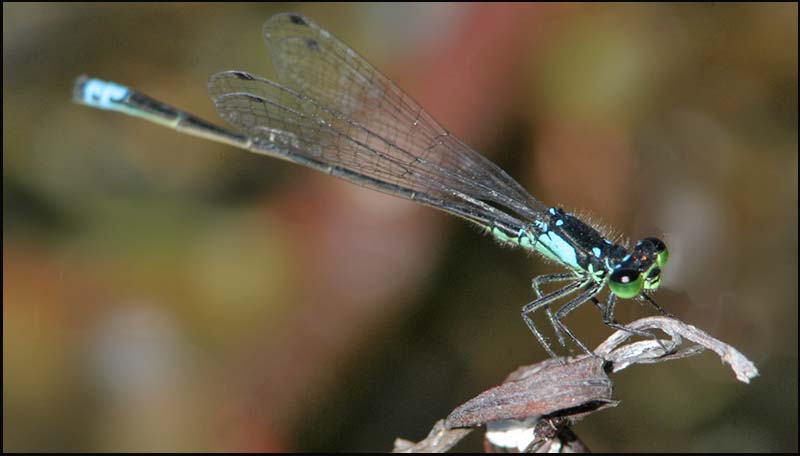
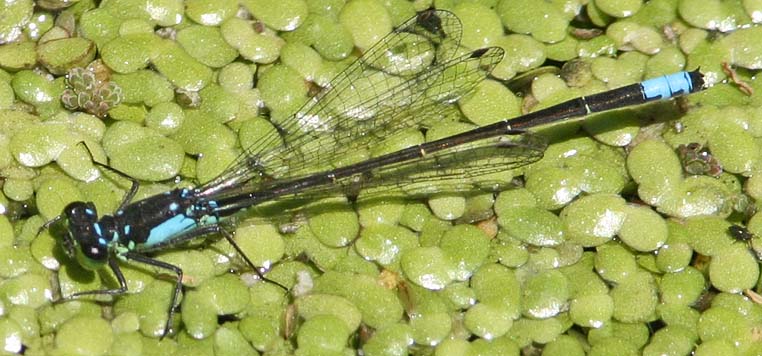
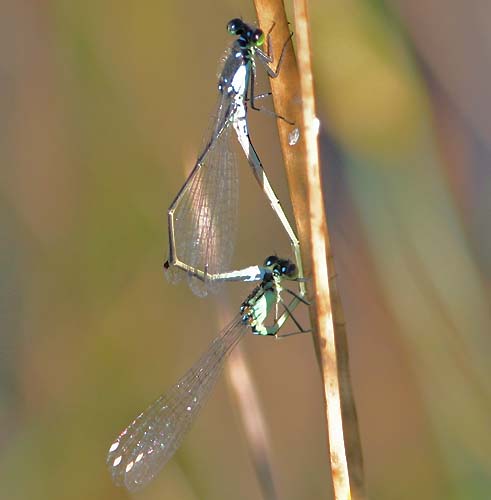
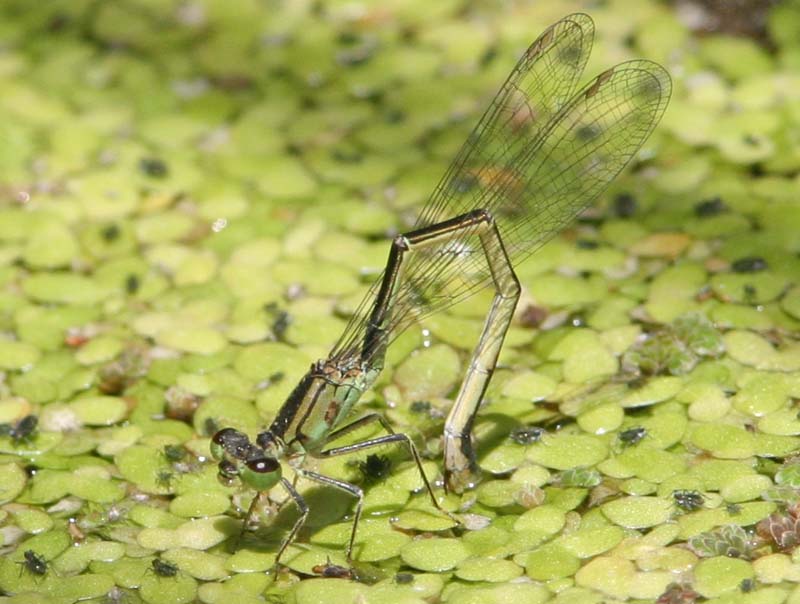
 An andromorphic female is more
like a male with an aqua-blue and black pattern, but this one (right)
is quite young because of the orange spots behind the eye. Note that
the "blue tail" (blue patch near end of abdomen) encompasses only the
8th segment in females (males have both 8th & 9th segments blue).
Some andromorphic females are almost identical to males; others have a
'dash-and-a-dot' pattern atop the thorax (like an exclamation point),
but all have only one abdominal segment blue.
An andromorphic female is more
like a male with an aqua-blue and black pattern, but this one (right)
is quite young because of the orange spots behind the eye. Note that
the "blue tail" (blue patch near end of abdomen) encompasses only the
8th segment in females (males have both 8th & 9th segments blue).
Some andromorphic females are almost identical to males; others have a
'dash-and-a-dot' pattern atop the thorax (like an exclamation point),
but all have only one abdominal segment blue.
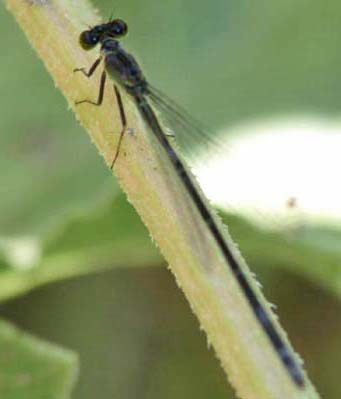
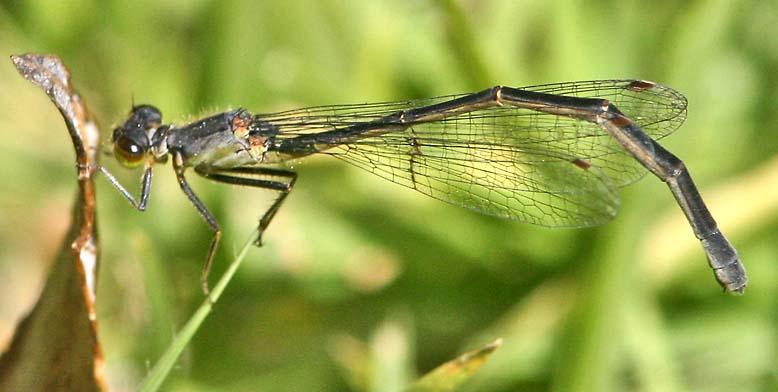
 All young female Pacifics,
though, apparently have orange spots between the eyes on the back of
the head. Very young female Westerns are orange all over.
All young female Pacifics,
though, apparently have orange spots between the eyes on the back of
the head. Very young female Westerns are orange all over.  Pacific Forktail is a common and widespread
species in MTY, as it is across western North America. The map shows
selected locales of specimens or observations, but it likely occurs
almost anywhere, at least in the lowlands.
Pacific Forktail is a common and widespread
species in MTY, as it is across western North America. The map shows
selected locales of specimens or observations, but it likely occurs
almost anywhere, at least in the lowlands.